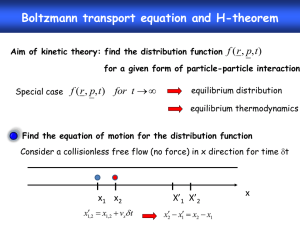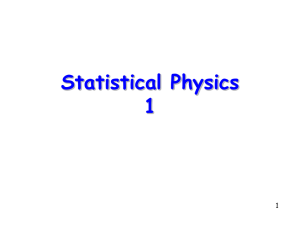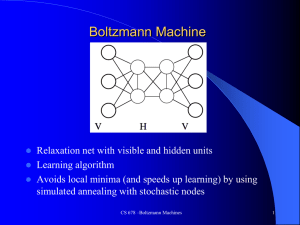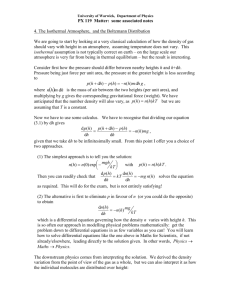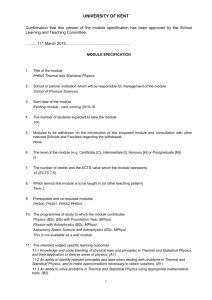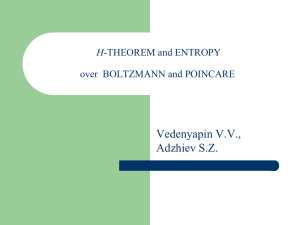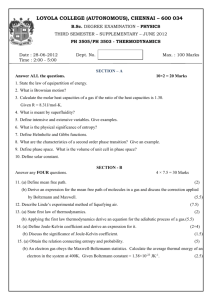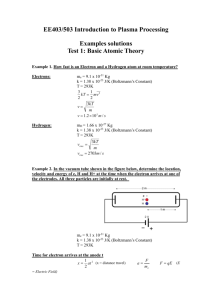docx - Ferment Magazine
advertisement
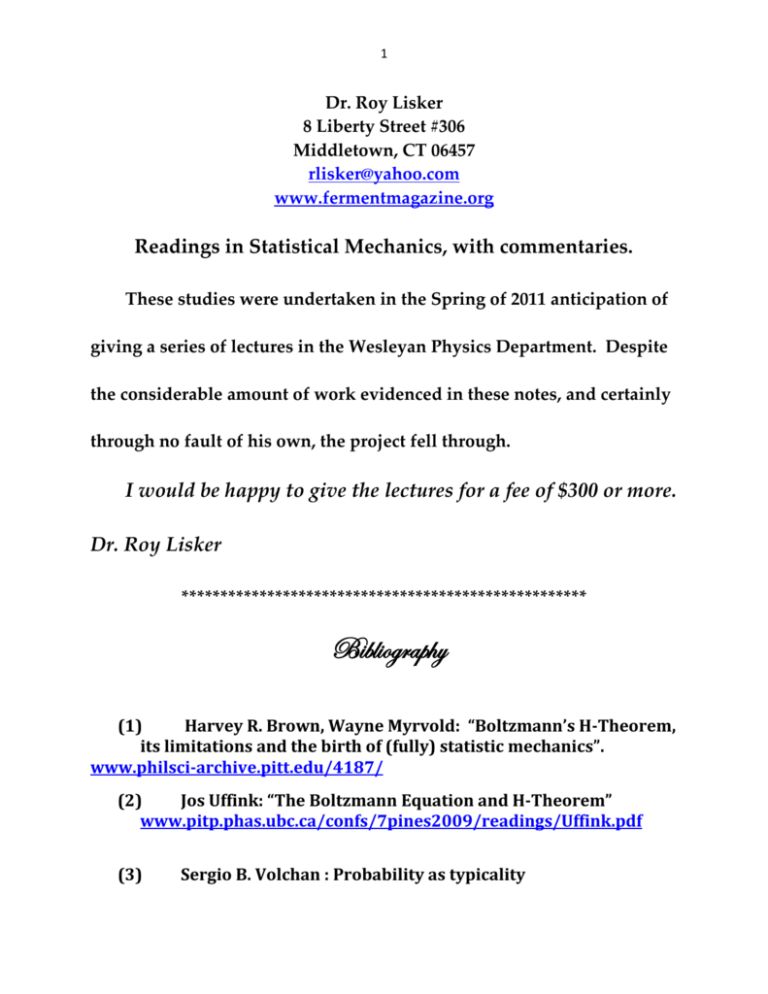
1
Dr. Roy Lisker
8 Liberty Street #306
Middletown, CT 06457
rlisker@yahoo.com
www.fermentmagazine.org
Readings in Statistical Mechanics, with commentaries.
These studies were undertaken in the Spring of 2011 anticipation of
giving a series of lectures in the Wesleyan Physics Department. Despite
the considerable amount of work evidenced in these notes, and certainly
through no fault of his own, the project fell through.
I would be happy to give the lectures for a fee of $300 or more.
Dr. Roy Lisker
****************************************************
Bibliography
(1)
Harvey R. Brown, Wayne Myrvold: “Boltzmann’s H-Theorem,
its limitations and the birth of (fully) statistic mechanics”.
www.philsci-archive.pitt.edu/4187/
(2)
Jos Uffink: “The Boltzmann Equation and H-Theorem”
www.pitp.phas.ubc.ca/confs/7pines2009/readings/Uffink.pdf
(3)
Sergio B. Volchan : Probability as typicality
2
http://arxiv.org/abs/physics/0611172
(4)
Cedric Villani: “M athematical topics in collisional kinetic
theory”
Handbook of Mathematical Fluid Dynamics (Vol. 1), edited by S.
Friedlander and
D. Serre, published by Elsevier Science (2002).pgs 71-305
(5)
Vincent S. Steckline: “Zermelo, Boltzmann and the recurrence
paradox”
Am. J. Physics 51 (10) October 1983
(6)
Ilya Progogine: “From Being to Becoming” 1980, Chapter 2
(7)
Stephen Brush: “The Kinetic Theory of Gases: An Anthology of
Classic Physics” Imperial College Press 2003
(8)
Enrico Fermi: Thermodynamics Dover, 1936
(9)
Gallavotti, Reiter, and Yngvason editors: “Boltzmann’s
Legacy”
Conference lectures by Giovanni Gallavotti, Elliot Lieb, Joel Lebowitz,
Carlo Cercignani, GD Cohen, Cedric Villani, W Reiter and others
European Mathematical Society, c2008.
(10)
A d’Abro: “The Rise of the New Physics” Vol 1,
Thermodynamics; Kinetic Theory Dover 1939
(11)
Ehrenfest, Paul and Tatiana: Conceptual Foundations of the
Statistical Approach in Mechanics Cornell University Press 1959
(12)
E Schrödinger: “Statistical Thermodynamics” Cambridge1964
(13)
Bergmann, PG “Basic Theories of Physics: Heat and Quanta”
Dover 1951
(14)
Georg Joos: “Theoretical Physics”, translated by Ira M.
Freeman Hafner Publishing 1934 Part V, Theory of Heat ; Part VI
Theory of Heat, Statistical Part
**************************************************************
3
From Ilya Progogine: “From Being to Becoming” WH Freeman 1981,
Chapter 2: The belief in strict determinism is only justified
when the notion of a well-defined initial state is not an excessive
idealization. Otherwise the concept of a world line must be replaced by
that of ensembles of world lines.
Gibbs, Einstein: A representative ensemble is a cloud of points that
is simplified into a continous fluid, with density = ( q1, , qs; p1 ,.., ps ; t)
. This “density” is fictive, but it allows one to make some sense of the
otherwise ridiculous idea that a fluid can have an invariant “Liouville
volume” fixed for all time, and a evolving “Boltzmann volume” that
equals the exponentiation of the ever increasing entropy.
A “microcanonical ensemble” is one that is uniformly distributed
on a constant energy surface
A “canonical ensemble” is a system in contact with a
theoretically infinite energy reservoir, at unvarying energy T.
4
What are the conditions that must be imposed on the dynamics
of a system to insure t hat the distribution function will approach either
the microcanonical or canonical ensemble?
A system is “integrable” if there is a Hamilton-Jacobi transformation that
transforms it into Action/ Angle variables, that is to say, constant first
integrals and trigonometric expressions. These eliminate potential
energy and have the simplified equations:
i H J d i dt
i
(
dJ i
dt
) 0 ; i it i
1
q j (2mw j J j ) 2 sin j
Pages 7-15 If all systems were integrable, there could be no
thermodynamic limit or approach to equilibrium . The time invariant
character of the Jj , fixes the long term behavior.
**************************************************
Gallavotti, Reiter, and Yngvason editors: “Boltzmann’s Legacy”
Conference lectures European Mathematical Society, c2008:
5
G. Gallavotti, E. Lieb, J. Lebowitz, C. Cercignani, GD Cohen, C. Villani, W
Reiter and others
Pgs. 7-15, Giovanni Gallavotti:
The “proof” of the Equipartition
Theorem in Boltzmann’s paper of 1872 is only value for isochore
transformations (no change in volume, hence Work =W= -pdV =0 ) and
depends on the periodic motions of individual particles. A closed
chamber of fixed volume, and with periodic motions. The “equipartition
theorem” follows: the uniform distribution in space will project
uniformly onto any fixed energy surface.
Boltzmann also assumes periodic motions for individual particles
without collisions, then tries to cheat by saying that non-periodic
motions are really infinite periods
Boltzmann looks for integral expressions that imitate or mirror
thermodynamic quantities and their behavior, then goes on to assume
that this is enough to make them the same things: qualitative similarity
becomes quantitative identity!
6
To quote Gallavotti: “The thermodynamic analogies for small,
simple systems transform into real thermodynamic relations for large
complex systems”
The fundamental relationship that he wants to preserve is
dS = (dU+pdV)/T
To justify this conflation of ideas, Boltzmann makes two
assumptions, both of which are demonstrably false:
Assumption 1: The Stoss- Zahl- Ansatz (density of collisions is the
same everywhere, and uncorrelated before collision. The irreversibility
then follows automatically from the fact that they cannot be uncorrelated
after collision)
Assumption 2: The Ergodic Hypothesis (Molecules go through all
possible states of motion. Or, time integrals equal space integrals.)
Gallavotti, continued:
Boltzmann’s fundamental paper of 1872:
7
(1) Identify absolute temperature ( at equilibrium) with average
kinetic energy per particle, over the periodic motion of a
macroscopic collection of N identical particles
(2) Energy U = H(p,q)
(3) Pressure is created by collisions of particles on walls
Given these assumptions, P can be identified with the time average
of the partial derivative with respect to volume of the energy. The
fundamental equation then follows (this is well demonstrated in Fermi’s
book on Thermodynamics ) Boltzmann’s endorsement of the ergodic
hypothesis is consonant with a picture of a “discretized phase space”
Points are “cells” of finite size. Then the ergodic hypothesis implies a
dynamic passage of the system through all the cells, as a 1-cycle
permutation. “It is very doubtful that the dynamics of a gas has only one
cycle”. The hypothesis breaks down in computer simulations. Needless
to say, “equipartition” becomes a triviality.
Gallavotti loosens up the ergodic hypothesis by the assumption
8
that it acts only on the “attractor” of the system. This has lower
dimension , measure 0.
**********************************************************
Pgs. 16-20 Elliott Lieb
Foundations piled on top of foundations:
Thermodynamics is founded on Statistical Mechanics
Statistical Mechanics is founded on
(1) Newtonian Mechanics
(2) Probablity Theory
Probability is founded on Measure Theory
Measure Theory is founded on
(1) Topology
(2) Geometry
Topology is founded on Set Theory
Elliott Lieb: Stat Mech is based on 3 absurd notions:
The ergodic hypothesis is ridiculous
The equipartition assumption is ad hoc
9
The Stoss-Zahl-Ansatz is self-contradictory
Why, then, does statistical mechanics work?
Elliot Lieb continued , pg. 27:
Invokes two styles of doing physics
(i)
Look at detailed interactions of particles
(ii)
Look at large scale effects of particle interactions
The latter was Boltzmann’a approach: “Search for a function (any
function) of the variables of phase space, that is continuous and
differentiable (dx. dS, dE are well defined) and always increasing in
time. In 1889 Poincare showed that there doesn’t exist any function of
the phase space variables that can do that.
A quote from JW Gibbs: “The laws of thernodynamics are easily
obtained from the principles of statistical mechanics, of which they are
the incomplete expression.”
Boltzmann’s insight: statistical ensembles lead to the Clausius
Inequality.
10
Little Boltzmann Equation: S = kBlogW . W is the area of the
surface in phase space. It is assumed that the energy surface is
discrete, and one uses “Boltzmann inflation”!
In the continuous limit:
S kB ln dq1...dqn dp1...dpn
Where is the probability density in phase space. When applied to
quantum mechanics the formula becomes
S kBTrace( ln )
20th century developments are a major departure from Boltzmann:
(a) Specific heats are suppressed relative to classical values
(b)Superfluidity, super-conductivity, Bose-Einstein condensates are
contrary to the assumption that the world becomes more chaotic
with time
(c) Contrast of gravitational degrees of freedom, radiative degrees of
freedom, and the collisional degrees of freedom lead to very different
ways of looking at Entropy over time.
11
(d)
The literal use of the Boltzmann entropy expression
Exp(H / kBT
gives a value of - ∞ for entropy at absolute zero. This means that
quantum mechanuics and the von Neumann trace matrix must be
brought into play.
**************************************
Joel Lebowitz:
Many conceptual and mathematical problems involved in the passage
from a time-symmetric Hamiltonian at the mictoscopic level, to a time
asymmetric diffusion equation at the macroscopic level.
(1) ”Atoms are simplified to the point of caricature”.
Quote from Feynman: “(Atoms are) particles in perpetual motion that
repel when squeezed”
(2) Irreversibility
(3) Coarse Graining. Notion of a “density” that makes sense only
when phase space is divided into indivisible cells.
****************************************
12
Commentary by Roy Lisker
Statistical Mechanics is in the best traditions of theoretical physics, and
Boltzmann was a genius in that tradition. There is a 6-step procedure:
Step 1: One accurately describes a phenomenon empirically which
is not understood theoretically . (Eg. The mathematics of
thermodynamics, which is really a description, not a theory)
Step 2: A model is proposed
Step 3: Lousy mathematics uses the model to derive pre-existing
formulae presented in step 1
Step 4: The mathematics is used to make predictions, which
exposes its limitations
Step 5: The mathematicians come in and clean up the mathematics
Step 6: The process advances BOTH physics and mathematics.
*****************************************************
A short list of the absurdities in the standard models for Stat Mech:
(1) “Density” of a “perfect massless fluid”
(2) Passage from a massless fluid of discrete particles, to a
13
continuous fluid, uncountably many points forming a continuous
volume. Counting is replaced by measure theory
(3) Confusion between “ensemble” picture of Gibbs, and
“configuration space” world-line of Boltzmann . To address this
confusion, Boltzmann invents the “ergodic hypothesis”
(4) After the fluid has been rendered continuous, the phase
space itself is “discretized”!
(5) Yet, to make the probability work, a measure is applied to
phase space, although measures are of necessity continuous.
Summarizing the bad mathematics
(1) The ergodic hypothesis
(2) Equipartition of energy
(3) Stoss-Zahl-Ansatz (molecular chaos)
(4) Treating the micro-canonical ensemble as a continuum
(5) Discretization of phase space
14
(6) Reversion to a continuum model for the phase space, so that one
can get the Maxwell-Boltzmann distribution
(7) The density of states
(8) Criterion for “equivalence” of microstates in the macrostate
(9) Loschmidt reversibility paradox
(10)
Poincare and Zermelo recurrence paradoxes. H-functions
can’t be constructed.
Quote, Gibbs: “The (postulate of) the impossibility of an
uncompensated decrease of Entropy seems to have been reduced to an
impossibility.”
Joel Lebowitaz, pg 70: This discussion should be read in conjunction
with the paper by Sergio B. Volchan : Probability as typicality
http://arxiv.org/abs/physics/0611172
Probabilistic “typicality” is central to the Gibbs ensemble
paradigm: All microstates with the same ‘typicality’ in their probability
are amalgamated to the same macrostate. This is used to cover over the
sheer impossibility of giving a precise “probability” to each microstate.
15
Applying this notion to differing perspectives of Gibbs and
Boltzmann:
Gibbs: The phase space volume ‘spreads out” like a liquid (ink
squirted into a glass of water), over the total phase space
Boltzmann: A individual trajectory in phase space (of trillions of
dimensions) covers the whole phase space in such a manner that it
spends almost all of its time in the “typical” rather than the “rare” boxes.
The Gibbs Paradigm
(1) Begin with a container, like a cylinder, holding 1020 “particles”.
(Recall that the atomic theory did not win acceptance until late in the 19th
century. These “particles” are already a discretization)
(2) Make this into a single point in a 1020 dimensional Configuration
Space .
(3) Create a continuous ensemble of systems with all possible initial
16
conditions , that is to say, all possible energy distributions (momenta are
considered less significant), under the constraint of a fixed total energy
E, (or a pizza slice of energies between E and E+dE ).
(4) Estimate the most typical outcome of the expansion of this fluid
into a larger enveloping cylinder, in a length of time t under
Hamiltonian collision dynamics ( which of course do involve momenta,
another mathematical anomaly.)
(5) By Liouville’s Theorem, the volume of the fluid doesn’t change, as
it “thins out” over the enlarged phase space VC2 from the initial cylinder
VC1 ,
(6) However, although we’ve worked with the fiction of a continuous
fluid, enabling us to use the Liouville Theorem, we now discretize the
phase space, to invent a fictive volume obtained by adding up the
number of cells that receive even one particle from the fluid.
Here, quantum theory helps, and one can give a minimal size
to the side of a typical cell in W, that is, it must be proportional to h.
Thus h is at the intersection in Nature, where the Second Law goes
17
over into the Uncertainty Principle. Therefore, Quantum Theory is
required to save even the most fundamental of all State Mech equations
S = kBlnW .
(7) The crucial difficulty is the Stoss-Zahl-Ansatz : namely, that all of
the microstates (cells of the phase space), have the same “likeliness”
before the process begins (hypothesis of molecular chaos, ergodic
equipartition). This diminishes with time.
One now argues that the various permutations of a microstate all
belong to the same macrostate. (These permutations remaining within
the same set of locations. These increase with the opening of cylinder
one into cylinder two) Simply stated, the fewer the symmetry principles
the higher the typicality.
By maintaining the ambiguity between the discrete and the
continuous, one introduces Measure Theory and argues that the volume
of special states has measure 0.
(8) The criterion of ‘typicality” is the Maxwell-Boltzmann distribution
of energies combined with a completely uniform spatial distribution.
18
(9) It is now assumed, rather grossly, that a fluid of constant
Liouville volume will typically cover all the cells of the new phase
volume. The special states are those which cover only part of the new
phase volume. But this makes nonsense of the Liouville volume notion.
(10)
Summarizing: maximal typicality has two features:
(a) Uniform distribution of particles (every cell has the same
number of “particles”.
(b) Maxwell-Boltzmann distribution of energies within each
cell! (The number of particles (cells?) with energy k = ½ v2 , is given
by
(11)
*************************************************************
Joel Lebowitz continued pg 75:
Cosmological considerations: the eternal problem of the “initial state
of the universe”. It must have had vanishingly small entropy. But this
seems to contradict the concept of a totally chaotic Big Bang.
19
Roger Penrose’s Solution: Low entropy for gravitational degrees of
freedom means a uniform distribution of matter. High entropy is
manifest in clumping
Low entropy for random motion (gaseous, inertial, not gravitational,
Gaussian distribution of velocities) means uniform motion. High
entropy means chaotic or Maxwell-Boltzmann distribution. Likewise for
radiation.
********************************************
Carlo Cercignani, in the Gallavotti Antology
(1) Boltzmann’s H-Theorem paper of 1872. There are two
interpretations of the distribution function:
(a) The fraction of a ‘sufficiently long” time interval during which
the velocity of a specific molecule has values within a certain volume of
momentum space
(b)The proportion of molecules which, at a specific instant, have
20
a certain velocity within a narrow range of velocities. Boltzmann
eventually realized that these were not equivalent and came up with the
Ergodic Hypothesis: the position and momentum of every molecule
eventually take up all possible values compatible with the given total
energy.
Ehrenfest’s assumption: T = kB( average of K.E. perm atom) . This is
only true for perfect gases and solids at room temperature.
List of assumptions in the Boltzmann Picture:
a. Molecules are hard, perfectly elastic spheres.
b. If the “state (p,q) is known with perfect accuracy, they can be
reduced to points.
c. Otherwise one invokes the probability distribution: let the
density be given by D=f(x,x, t); f0 = f at time t =0. Then
df
dt
G L f
t
f
x
The “Ldxddt” term, gives the expected number of particles
21
passing out of a “cell” because of a collision. Gdxddt gives the number
that enter. Obviously both are finite-usual uneasy back and forth
between density and number. The end result is (H-Theorem paper of
1872):
f
f
x
N 2 ( f ( x, ' , t ) f ( x, 1' , t ) f ( x, , t ) f ( x, 1 , t ))(1 ) nddn
t
R3 B
List of hidden assumptions:
(1) Stoss-Zahl-Ansatz. Although this must be present initially. It is
immediately destroyed by the interactions. However, it is argued that “it
is only needed for molecules which are about to collide. However : “It is
very hard to to prepare an initial state in which chaos does not hold.”
One cannot, however, have non-correlation both before and after a
collision. This is the Loschmidt argument against the H-Theorem.
22
In fact, according to Cercignani, the H-theorem seems to have a very
limited validity, and is only used in studying the properties of dilute
gases.
Since 2000 the Boltzmann equations have been the basis for
extensive mathematical investigation and a search for rigorous solutions.
(i)
1933 Proofs of Existence and Uniqueness for gas of hard
spheres (Thespace is homogeneous, dependency on velocity
and time, but not on position)
(ii)
1949 Harold Grad’s theorems . Use of orthogonal polynomials
(iii) Lanford’s famous theorem. Deriving Boltzmann
irreversibility from reversible mechanics under very restrictive
conditions.
**********************************************
E.G.D. Cohen, from the Gallavotti Anthology : Entropy, Probability,
Dynamics
23
Boltzmann’s papers:
(a) 1872, Mechanistic approach
(b) 1877, Probability approach. This may have been influenced by the
criticism from Loschmidt. The formula S= klnW comes from a paper of
1887, and only applies to an ideal gas in thermal equilibrium.
Now a new idea, different from “typicality” or “likeliness” appears:
“complexions. Complexions are an additive progression of discrete
energies , …These are hypothesized to be invariant both before and
after collisions. Each distribution of total kinetic energy is a
“complexion”. The number of molecules with energy j is designated as
j. Then the number distinct energy distributions, P, that one wants to
maximize is given by
P
N!
q
j!
j 1
One employs basic combinatorics to derive the partition function.
24
*****************************************
Erwin Schrodinger: “Statistical Thermodynamics” Cambridge UP 1964 .
Using Stirling’s formula, one quickly derives
s ~ Exp(
s
);
E
(
)
N
One method covers all forms of statistical physics, whether classical,
quantum, Fermi-Dirac, Bose-Einstein, etc.
The principle problem in statistical thermodynamics is the distribution
of a given amount of energy E, over a huge number of identical systems,
atoms, molecules ,quanta.
A related, secondary issue: distribution of N identical systems over all
possible states, given a fixed amount of energy E.
One disregards the interaction energy, gravitation, etc. This allows
one to speak of an absolute energy per particle which is not shared.
25
Momentum is not considered, which is strange, since the motor of
change is via collisions.
The standard sophistry: From one end: describing those features
which are common to all possible states of the assemblage, which
therefore “almost always” obtain.
From the other end: Those little boxes each with their single state.
This creates two different attitudes towards the mathematical application
to the physical results.
Attitude 1: N existing physical systems in real physical
interaction.(electrons, gas molecules, Planck oscillators). This viewpoint
only works with gases. There must be many identical constituents, and
violates the very notion of a solid
Attitude 2 ( Willard Gibbs): N identical systems are mental copies of
the one system. What, then, does it mean to distribute energy over N
systems? We are free to regard any one of these systems as the one
actually under observation
26
Consider N identical systems. The list of possible energy eigenvalues is
1 , 2 ,..., l ,...
l 1 l
If the system is classical, it is completely determined once one knows
that S1 is in state l1 , S2 in state l2, etc. This isn’t true for quantum statistics
which invokes probability amplitudes Each state has an “occupation
number”, aj , which gives the number of electrons in a given state.
P
N!
a1!a2!...al !...
al N ; ai i E
E ai i
N
al
Boltzmann observed that the maximum for P is astronomically
much larger than any lesser value. This can be shown rigorously for
N ∞ . However, when N becomes small one must pay attention to the
fluctuations of Brownian motion. The standard treatment now follows.
27
To maximize ln P, we use the technique of Lagrange multipliers to the
expression :
A ln P N E ln N !( ln ai !) ( ai ) ( i ai )
All of the ai’s are treated as if they were continuous, autonomous
variables, although in fact they are integers. A better approach therefore
would be to use the ratios of the ai’s to N, which, in the limit can be
approximated as continuous variables. In any case, one invokes a crude
approximation of Stirling’s Formula, then takes the derivative:
ln k! k (ln k 1)
A ln N ! al (ln al 1) ( ai ) ( i ai )
A
al
ln al 1 1 i
Hence
ln al l 0
Solving for each al gives :
28
al e
l
N e e
l
E l e e
l
These are the basic formulae of of Stat Mech, from which the
quantities of Thermodynamics, and the partition function, are
derived. The partition function is the expression for E/N.
***************************************************
Commentary
Mathematically this procedure is outrageous!! The aj’s are huge
integers, one can hardly speak of “differentiating”. In the Stirling
formula, these extremely discrete functions making huge leaps are
replaced by an “asymptotically continuous” function, with meaningless
infinitesimal increments producing controllable increases on the range.
Then, worse still, one applies Langrangian Multipliers! Obviously
there are othe means to the same results, but the procedure is ..well…
absurd!
**********************************************
29
e
E
U l e
N
e
el
(ln( e e )
l
l
Clearly one can get rid of .
ln al l
The multiplier turns out to be the temperature. This is not
surprising as its inverse is the integrating factor for dQ. To demonstrate
this, Schrodinger imagines the interaction of two quantities of perfect
gases, A and B. He (somewhat arbitrarily) assumes that the energies of
the new mixture ek , are arbitrary sums of the energies of the old, m, and
n : k =m +n .. Then he shows, or claims to, that if the of the first
mixture = of the other mixture, their interaction produces no work,
because the of the combination will also not change. He also shows
that 1/ is the integrating factor . The specific equation, which is easily
seen to be the basic equation of thermodynamics in disguise, is
30
F (T )
1
kT
d ( F U ) (dU
1
ql d l )
N
The expression on the left is the “free energy”. Substituting
in previous formulae gives the classical form of the Partition
function:
Z e
el
kT
The free energy is given by
F (T ) k ln Z
U ST
T
Thus:
All of thermodynamics comes from the Free Energy
and the Partition Function.
******************************************
31
From Fermi’s Thermodynamics
Even the term “state” means different things in Thermodynamics
and Statistical Mechanics. The equation of state in Thermodynamics
connects pressure, volume and temperature F(p,V,T) =0. The normal
procedures is to make a Cartesian system of two of these variables, then
draw isobars of the third variable, or some quantity compounded from
them , “isothermals”, “isochrores”, etc.
(1) homogenous system is mixture of several compounds, with a
“global” equation of state.
(2) A nonhomogenous system has several compounds each with its
own state equation.
(3) Systems with moving parts. In thermo (not in stat mech) one
neglects the kinetic energies of the moving parts. The values of these
kinetic energies (see Schr) are the “states”. Thus, an infinity of “states”
of molecular motion may correspond to a single thermodynamic state.
Hence the origin of the ensemble approach of Gibbs.
32
Equilibrium “states”. Systems transform from an initial state to a
final state through a continuous succession of infinitesimal intermediate
states. This is the origin of all the headaches felt by physicists and
mathematicians, albeit for different reasons.
Example: reversible expansion of a gas. Enclose gas in cylinder with
piston, raise or lower piston infinitely slowly! (Since the basic equation
of Thermodynamics is a total indifferential (hah!), this eliminates the
pdV , or work term, and just leaves the heat.
Cycles. The work done by a cycle is the area enclosed in the loop, in
the (p,V) plane in the Carnot process (lifting and lowering pistons,
moving cylinders to infinite heat soruces at fixed temperatures) .
For a “perfect dilute gas”, the equation of state is pV= (m/M)RT
R is the “gas constant”= 8.314x107 erg/degrees = 1.986 Cal/degrees
m is the number of grams of gas; M is the molecular weight of the
element or chemical (e.g. water)
A gram-mol is a weight whose numerical value, in grams, is equal to the
molecular weight of the substance. Thus, m/M = 1 for any gram-mol.
33
Density = m/V = pM/RT. For an isothermal expansion, one has dT=0,
and
V2
L V pdV (m
1
(m
V2
M
) RT V
1
dV
V
V
p
) RT ln( 2 ) (m ) RT ln( 2 )
M
V1
M
p1
In a mixture of gases, the partial pressure of a component is the
pressure that this component would exert if it alone filled the container.
Dalton’s Law: The pressure of a mixture of gases is the sum of its partial
pressures
***************************************
Georg Joos: Theory of Heat
The small calorie is the amount of heat required to raise the
temperature of one gram of water from 14.5o to 15.5o Centigrade. The
large calorie is the amount needed to raise 1 kilogram of water from 14.5 o
to 15.5o .
Specific heat: the amount of heat that raises a gram of a specific
substance by 1 degree.
34
Molecular heat : the amount that raises one mol of the substance by
one degree.
Okay: here is the basic calculation for finding the “intermediate heat”
when quantities of two substances at different temperatures are brought
together. For example qs of substance S at temperature Ts is brought into
content with qw of another substance at temperature Tw . If the specific
heats of S and W are cs, then
qs csTs qwTw (qs cs qwcw )T
T
qs csTs qwTw
(qs cs qwcw )T
“Heat transferred from one body equals heat absorbed by the receiving
body”
***********************************************
Back to Fermi:
The First Law of Thermodynamics
This is simply a restatement of the conservation of energy for
thermal systems. The assumption is that the variation of energy must
equal the amount of energy received from the external environment.
35
Hence the use of the minus sign –L, as the work “performed” by the
system. If A and B are two states of a system, then –L = UB – UA is the
work performed “by” the system, which is –the work “on the system.
Work is a total differential, and path independent .
An example of “two ways” of going from A to B (Water to Steam)
1. Heat water on flame to raise temperature from A to B. The volume
changes very little, and one says there is no “work” done on the
system.
2. Use rotating paddles on central to heat by friction. In this case
mechanical work was used to keep the paddles moving.
Example 2, basically the Carnot Cycle
(1) S is a cylindrical container, perfectly insulated. Bring in a
moving piston. This changes the volume
U U B U A L
U L 0
If the insulation is not perfect,
U L Q is the amount of energy
received by means other than mechanical work. It is a leap of speculation
36
for Boltzmann to claim that this comes from the agitation of molecules or
atoms. For a “cyclic” transformation U = 0: “The work performed by the
system equals the amount of heat absorbed by the system” That is the
Carnot cycle. We can now derive the basic equations of
Thermodynamics:
dQ dU pdV
U
U
dU ( )V dT ( )T dV
T
V
U
U
dQ pdV {( )V dT ( )T dV }
T
V
U
U
dV ( p ( )T ) dT ( )V
V
T
One can also take p and T as the independent variables. Then
dQ dU pdV
U
U
dU ( ) p dT ( )T dp
T
p
V
V
dV {( ) p dT ( )T dp}
T
p
U
U
U
V
dQ dT (( ) p ( )T ) dp (( )T p ( )T )
T
p
p
p
Finally, one takes V and p to be independent variables. Then
37
dQ (
U
U
)V dp dV (( ) p p)
p
V
Definitions: Thermal Capacity is given by dQ/dT . There are two thermal
capacities depending on whether heating is done under constant volume,
or constant pressure:
U
dQ
)V ( )V
T
dT
U
V
dQ
C p ( ) p p( ) p ( ) p
T
T
dT
CV (
Making Thermodynamics palatable to the mathematician
(1) Work, heat, entropy are quantities in transitions or transformations
(2) Because they are measured in “equilibrium states”, they are
presented as infinitesimals. This is the basis of thought experiments in
which processes move with infinite slowness. (Call up Zeno!)
(3) Basic equation is dQ=dU+pdV . - L is work done on the system, L is
work done by the system.
(4) dU and dV are total differentials in variables p,V, T. It is customary
38
to let V be the dependent variable, because p, T are active. V being a
measure of empty space is treated as passive.
(5) dQ is not a total differential. To evaluate the integral that calculates
the quantity of dQ one must have a trajectory on the (p,T). Essentially
one can then express both parts as a function of temperature.
(6) 1/T is an integrating factor. Thus , S = dQ/T is a total differential.
One relates U to T by the hypothesis, a quasi-theorem, that defines
temperature as the particle average of the total energy. Then if
(7) dQ/T = dU/T +fdV/V= NdU/U+kd(lnV)= d(lnUNVk)
************************************************
Page 164: Fermi’s derivation of all the properties of entropy, using
the model of the Carnot cycle. All we need from this is the derivation of
the fundamental integral (which figures in the H-theorem)
dQ
T 0
Fermi on Entropy , quote: “In an isolated system, the statistically
significant transformations occur take the system to a state of higher
probability”
39
It is easily shown that the sum of entropies is given by the product of
probabilities S = klnW . k = R/A = Gas Parameter/Avogadro’s Number
Going back to our definitions of thermal capacity, if CV is fixed, then
S=CVlnT + RlnV + a (constant of integration) = lnTCVVAk
IF Cp is constant, we get
S=CplnT –RlnP +RlnR
Putting these together, one derives the important formula
(
U
p
)T T ( )V p
V
T
The van der Waals Equation
The ideal gas law pV = kT works well for high temperatures and low
pressures, or high volumes. The van der Waals law is a correction for
gases near their condensation points. It takes into account the size of the
molecules and the cohesive forces between them.
The gas law is modified as follows: (p + a/V2)(V-b) = RT
40
a and b are characteristic coefficients for specific substances. b is a
function of the size of the molecule, while a/V2 reflects the cohesive
forces.
We look at the “critical point of inflection, C”, or so-called labile
states of very high pressure before condensation sets in.
********************************************************
Cedric Villani: “A review of mathematical topics in
collisional kinetic theory” Handbook of Mathematical Fluid
Dynamics (Vol. 1), edited by S. Friedlander and D. Serre, Elsevier
Science (2002).pgs 71-305
The subject of Villani’s treatise is Collisional Kinetic Theory, a
branch of Non-equilibrium Statistical Physics. It is based on a small
number of famous mathematical models. There is more emphasis on
methods and ideas than on results. Fully non-linear theories are more
common than perturbative approaches.
Chapter 1
The Distribution Function
“The object of kinetic theory is the modeling of a gas (or plasma) by a
distribution function in the particle phase space”
41
Single species of particles, non-quantum, non relativistic. The
macroscopic variables are positions, the microscopic are velocities.
Consider the gas to be contained in a domain X in 3-space, in a time
interval (0,T).D= density = f(t,x,v) is the distribution function. F is a
function of bounded measure for any compact subset of X. In physical
space, the domain is assumed to contain a finite amount of matter.
There are two ways to interpret f
(1) As an approximation of the true density in phase space
(2) As a probabilistic strategy for dealing with our lack of knowledge
The Kinetic approach was created by Benoulli and Clausius long
before the experimental evidence for the existence of atoms.
The Fundamental Ansatz :
ALL measurable macroscopic quantities can be derived from
microscopic averages.
( Comment: This doesn’t say anything about the causal
mechanisms, how one gets from the molecules or atoms to the
42
measurable phenomena. Different pictures could give different
results)
Variables: x, t, v , T , density . Then :
R f (t , x, v)dxdtdv
3
If x and t are fixed, this becomes an integral of the single variable ,v.
We express the equipartition and conservation equations as follows.
Let u be the fixed velocity, v the variable under the integral sign. Then
u R vf (v)dv
3
u 2 NT R v 2 f (v)dv
3
The “transport operator”. The assumption is that the “density”
propagates without compression, expansion or change. This is, in
essence, Liouville’s Theorem: f(t,x,v) =f(0, x-vt,v) x and v are of course
abbreviations for 3-tuples. The total time derivative of f can be broken
into a temporal part and a gradient:
Dt f f
t
v f 0
43
The gradient part is what is known as the “transport operator”. If
there is a macroscopic force, F, then this equation is given a
Newtonian modification as:
Dt f f
t
v x f F v f 0
Only binary collisions are considered: 3 or 4 particle collisions are
considers too rare to bother with. The model used here will be that of
“hard, elastic spheres” with radii r, nr2 ~1, nr3 < 1, where n is the number
of particles .
The 5 assumptions:
(1) The gas is dilute
(2) Collisions are very brief events at very precise locations ,x .
(3) Collisions are assumed perfectly elastic. Therefore
Velocities before collision
Velocities after collision
v ' ,v*'
v,v*
44
v 2 v* v'2 v* '2
2
v v* v' v* '
Then
v v* v v*
2
2
v v* v v*
v* '
2
2
v'
is the “deflection angle”, = sin
Everything is microreversible
Molecular chaos (Stoss-Zahl-Ansatz! ) “The velocities of
particles before collision are uncorrelated”
When Boltzmann realized that it could not continue to apply after
collisions, he invented the Ergodic hypothesis.
Using these 5 assumptions, Boltzmann derived the Quadratic
Collision Operator, which we will write out in full:
f
Dt f v x f Q( f , f )
t
R dv* S B(v v* , )( f ' f*' ff* )d
v2
3
2
As a general rule, the kernel, B, is not integrable. The flux term in
f,which is a tensor product in probabilities, is allowed because the
45
particles are uncorrelated before collision. Even though they are no
longer uncorrelated after collision, Boltzmann continutes to use the same
expression. This in essence is the Loschmidt objection.
Here is how the 5 assumptions go into the integral and the theorem
(1) Only binary collisions are assumed
(2) t and x are treated as parameters, that is to say, the collisions are
localized in time and space
(3) Collisions are perfectly elastic, as required for the tensor product
(4) The microreversibility is built into the structure of the kernel B
(5) Stoss-Zahl-Ansatz
Note that Df is linear, while Q(f,f) is non-linear
Here Villani goes into a discussion of several traditional potentials that
produce the kernel B. A general classification of collision kernels:
A. Artificial collision kernels. No corresponding
phenomenon in nature, but useful for making calculations
B. Cut-off kernels. Replace kernel by another that is locally
integrable
46
C. Variable hard spheres
D. Condition of specular reflection (Fermat)
E. Maxwell diffusion. A special Gaussian distribution found
only at the wall
F. Linearized Boltzmann equation, etc.
As for the physical validity of the H-Theorem equation, it works
only in dilute atmospheres, for example aeronautics at high altitudes, or
interactions in dilute plasmas.
Both Loschmidt and Poincare can be ignored in an appropriately
small box of phase space and time, (Comment: That’s like saying the
earth is flat provided one stays within a 2 block radius)
Although there are 3 kinds of kernels (hard spheres, oscillators and
incompressible fluids), the mathematical theory has been developed only
for the hard sphere case.
Harold Grad’s work begins with Newton. His theorems were not
shown to be consistent until 1972, by Cercignani.
47
The Harold Grad approach
Hard spheres of radius r. Billiard reflections, “symmetrical densities”:
particles are ‘indiscernable though at a distance r from each other.” The
Flow St on the hard spherical particles induces a “flow on the
probabilities”. Take the continuum limit n ∞, r ~√(1/n)
Boltzmann –Grad assumption: f becomes continuous as the number of
particles becomes sufficiently large. Also, as n goes to infinity, the
motions of the particles becomes independent, t hat is to say,
uncorrelated.
With these assumptions, one can show that the limit function of the
process Pfn is a solution of the Boltzmann equation.
Landford’s Theorem: This proves the Boltzmann equation and
relations for very short time intervals and strong assumptions on the
iterations Pkfn . These are:
(i)
F is “continuous”
(ii)
Gaussian type limits
(iii) Uniform convergence of Pkf0n .
48
(iv)
Chaos assumption
The arguments are exceedingly vague. Notion of “most likely”
distribution is basically the same as the Stoss-Zahl-Ansatz.
1 n
We say that z is “admissible” if Wz ( x xi , v vi ) is a “good
n i 1
approximation to the density function f(x,v)dxdv. Then fn will be
“arbitrarily close” to the tensor product
f n in the sense of the “weak
convergence of the marginals” . This condition is not sufficient to derive
the Boltzmann equation.
Then there is the “problem of the localization of collisions”
Summarizing the mathematics:
Assume that ftn can be derived from f0n by transport under the
mechanisms of microscopic dynamics. Let tn be a probability measure,
with density ftn . Then, for all bounded, continuous f(x,v) on Rx3xRv3, we
have :
tn ( x, v)(Wz ft ( x, v))dxdv 0 , where ft is the saolution
to the Boltzman equation with initial f0 and the z operates only on the
49
“admissible points” . This means that “unlikely configurations” could
lead to very bad approximations. (Landford 1973)
***********************************************
From Stephen Brush: “The Kinetic Theory of Gases: An Anthology
of Classic Physics” Imperial College Press 2003
Outline of Boltzmann’s H-Function paper of 1872
Boltzmann constructs the following integrals
Q( f , f ) R dv* S B (v v* , )( f ' f*' ff* )d
3
2
Q( f , f )dv dv R
3
dv* S B(v v* , )( f ' f*' ff* )d
2
ln f
Q( f , f ) ln fdv Df
By an (excessive!) series of manipulations involving changes of
variables and integration by parts, which could certainly have been
simplified and takes up many pages, Boltzmann arrives at:
D( f )dt
1
f ' f*'
dvdv*dB(v v* )( f ' f ff* ) ln( * )
4
ff
'
*
50
Note that the integrand is of the form (X-Y)(lnX-lnY). Assuming that
the kernel is positive, this means that the integral will always be > 0 .
Therefore the derivative will be positive, and the quantity D will always
be increasing.
Commentary
Boltzmann therefore:
(1) Identifies D with the entropy
(2) Assumes that it rises to a maximum
(3) That this will happen in finite time
(4) Assumes that the integrand is continuous, and therefore that D
is differentiable
(5) Assumes that this maximum is stable, that is, there will not be
jumps along the way
(6) Assumes that the maximum is a finite number
(7) Argues that the distribution at the unique critical point will be
the Maxwell-Boltzmann distribution derived from the
equipartition of energies.
51
Putting everything together:
f f ( x, t , v )
H f ln fdxdv
dH H
v H D ( f , x)dx
dt
t
****************************************
Brush Anthology, continued
James-Clerk Maxwell papers of 1866-68
The assumption in these is that molecules behave like point centers of
force mean values of various functions of velocities, and variations
around these mean centers. Only collisions are considered, no external
forces, gravity, diffusion, etc.
“Now we know that in fluids the elasticity of form is evanescent, that
of volume is considerable” He invokes a cardinal principle of elasticity
“Forces caused by small changes in form are proportion to these caused
by small changes in volume”.
52
Gives up on a theory based on elasticity of stationary molecules, goes
on to consider moving molecules. Dynamic theory: molecules oscillating
around a fixed location.
****************************************************
Harvey R. Brown, Wayne Myrvold: “Boltzmann’s H-Theorem, its
limitations and the birth of (fully) statistic mechanics”.
www.philsci-archive.pitt.edu/4187/
Boltzmann’s 1872 H-Theorem paper : Gas composed of hard
spherical molecules. The container has perfectly elastic walls. Only
binary collisions considered. To be precise: Boltzmann claims that he is
working with perfect Euclidean points, but in fact the treatment uses
hard elastic spheres.
Boltzmann’s Transport Equation. Assumes isotropic. This means
that
f
t
depends only on collisions that alter v.
Harvey Brown invokes a particular form of the Stoss-Zahl-Ansatz .
This turns out to be equivalent to
F (v1 , v2 , t ) f (v1 , t ) f (v2 , t ) where F
is the density of those pairs of molecules which are destined to collide
within the period (t, t+t).
53
The “H-functional” is defined as
H f ( x, v, t ) ln f ( x, v, t )d 3rd v
Criticisms of Loschmidt, Poincare and Zernelo.
The consistency of the Boltzmann equation is at the heart of
Lanford’s Theorem. Specifically, there are two possible ways to approach
the evaluation of the Boltzmann equation, and Lanford questioned their
equivalence:
(1) Initial t. Let microstates of gas evolve according to classical
mechanics. Then observe the final microstate and use this to
determine the distribution function
(2) Solve Boltzmann equation for the distribution function at the
initial time t, and use this to determine the terminal microstate.
(3) Models: Ehrenfest wind-tree 1912; Dog Flea 1907
; Kac ring model 1959.
******************************************************
54
CHRONOLOGY
1874 Maxwell, Thomson and Tait recognize that the Boltzmann
equation does not really “explain” time irreversibility”
1876: Loschmidt Umkehreinwand
1890: Boltzmann publishes articles in Nature
1894: Culverwell objections
****************************************************************
Jos Uffink “The Boltzmann Equation and H-Theorem”
www.pitp.phas.ubc.ca/confs/7pines2009/readings/Uffink.pdf)
Uffink points out that there is nothing in the original H-Theorem that
guarantees that the gas will eventually reach its stationary or minimal
value. It’s not certain that it shows that when it reaches this minimum it
will stay there for an indefinite period.
1889 Poincaré. Classic paper: No monotonically increasing function
can be defined on coordinates of a system subject to Hamiltonian
dynamics
1893 Poincaré: Criticism of Boltzmann and Helmholtz arguments
55
1890 Zermelo “Wiederkehreimnwand”
1893 Poincaré: “Irreversibility is in both the premises and the
conclusion”
1898: Poincaré paper on the stability of the solar system. Uses a very
strange argument: ” The planets give off heat that dissipates in space, and
will therefore reach a Boltzmann equilibrium.”
1896 Zermelo: The stationary limit to which Boltzmann alludes cannot
be stable, and is therefore not truly stationary.
In response to Zermelo and Loschmidt, Boltzmann endorses
probability.
56
